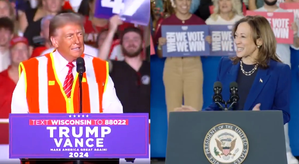New York: A polarised US votes in an air of uncertainty on Tuesday for a President who will guide its destiny – and have an impact on the world – over the next four years.
The nation could make history by electing its first woman President, Kamala Harris who is of partial Indian descent, or re-elect Donald Trump, who had been defeated in 2020 after his first term.
The vicious campaign leading to the election was marred by violence with Republican Trump surviving two assassination attempts, one of them injuring him.
Vice President Harris became the party’s unexpected candidate just three months ago after President Joe Biden dropped out after he stumbled in a debate with Trump, showing signs of weariness of age.
She faces Trump, who has been campaigning non-stop for four years since his defeat that he has refused to admit.
Trump has promised a return to a “Golden Age” when America was great while Harris said she will turn the page for a new beginning of amity and cooperation.
While Trump has a record, however controversial it may be, Harris has had limited opportunities to distinguish herself in only three months of campaigning after emerging from Biden’s shadow.
She faced the challenge of shaking off the legacy of the Biden administration with its record of inflation and surging illegal migration.
All the aggregation of polls showed a tie between the two candidates which in turn points to a photo finish.
By the time the first polling stations open at 5 A.M. (3:30 P.M. in India), about 81 million voters of the total electorate of 186.5 million – about 43 per cent – would already have cast their ballots through the early voting process.
The results are unlikely to be known by the time the last polling stations in Alaska and Hawaii close at midnight (10:30 A.M. Wednesday in India) if the results are so close that the postal votes can make a difference to the results.
The popular votes don’t count as much as the candidates’ performance in the seven swing states which are not firmly entrenched on the side of either party and can, therefore, decide the winner because of the electoral college system.
The 538 electors in the electoral college, who elect the President, are distributed according to the size of the states, and the winning candidate has to amass 278 electors, with those from the swing states making a difference.
–IANS


Comments are closed.